Have you ever taken a photo while travelling and thought, “This picture is forever?” Timeless travel photography is just that: images that do not breathe date or time but only evoke atmosphere, romance, and nostalgia. It refers to the art of capturing moments and scenes of travel in a way that transcends immediate experience, creating images that evoke emotions and tell stories long after the moment is over.
Whether you are just starting in photography or already have some experience, you can capture this magic with the proper techniques. In this blog, you will discover practical tips for taking timeless travel photos, from composition to post-processing. With these tips, you will take iconic travel photos from now on.
I also published a comprehensive blog on travel photography some time ago: go there, too. My blog discusses different aspects of travel photography, such as composition.
In cities, of course, you come across a lot of architecture. So, it might also be worth checking out my blog on architectural photography.
Content
- What makes a travel photo timeless?
- Observation and preparation
- In-camera techniques for timeless travel photos
- Post-processing tips for timeless travel photography
- Timeless travel photos under challenging conditions
- Take your time
- Need ideas for your next trip?
- Conclusion: Let timelessness speak through your lens
1. What makes a travel photo timeless?
Timeless travel photographs avoid modern disturbances and capture the essence of a place. They evoke emotions and tell stories that stand the test of time. Here are some tips to make your images timeless:
- Avoid modern interference: Consider satellite dishes, road signs or graffiti. Choose a composition that excludes these elements. Framing can help with this. If it fails while shooting, remove disturbances in post-processing.

Sample photo: At first glance, a photo of the houses inside Dubrovnik’s fortress walls seems timeless. But a closer look reveals satellite antennas and air-conditioning units. Zooming in and avoiding distracting details creates a calmer image.
- Focus on simplicity: A clear main subject without distractions attracts attention. Details such as textures, colours and local customs add depth. These small elements tell more about the culture and environment than broad panoramas.

That same evening in Dubrovnik, but more zoomed in and the camera pointed upwards to eliminate all distractions, I still found a timeless and simple image.
- Play with framing: Use natural frames, such as arches or trees, to mask interference. Classic composition techniques, such as the rule of thirds and outlines, help create visually appealing images. These techniques guide the viewer’s eye through the photo and create balance and interest.
- Use light deliberately: The right light makes a world of difference. Take advantage of the golden hour – just after sunrise or before sunset – when the light is soft and warm. This adds atmosphere and depth to your photos.
- Evoke emotions: Timeless travel photographs touch the viewer by evoking emotions. Whether nostalgia, joy or wonder, the aim is to capture your feelings.
- Tell a story: Every timeless photograph is a visual story. Summarising the essence of a place, its culture, and its people transforms an image into a lasting memory.
2. Observation and preparation
Timeless photos start with a good eye for detail and thorough preparation. Here are some tips for capturing a scene in the best possible way:
- 1. Analyse the scene carefully: Look at the surroundings and determine what disturbs the timeless quality. Think modern vehicles, stickers or busy background details. This skill becomes natural with practice.
- 2. Choose locations with potential: Look for places that exude an authentic atmosphere. Think of an old alley, an iconic bridge or a picturesque landscape. Check for distracting elements, such as traffic signs or cables, and adjust your position or composition to avoid them.
- 3. Wait for the right moment: Patience is essential for a timeless photo. Wait until tourists, vehicles, or other distractions are out of sight. A few extra minutes can distinguish between a good and a perfect shot. Prepare your camera settings in advance so that you are ready to capture the scene in the best possible way.
- 4. Make multiple attempts: Sometimes, finding the ideal composition requires multiple shots. Try different angles, perspectives, and settings to get the most out of your location.
This saves time in post-processing and produces an authentic image. Sometimes, the ideal composition requires several attempts.
For example, while visiting a busy market, you can wait for the crowds to move away and photograph the colourful stalls without interference. This saves time in post-processing and provides authentic images.
3. In-camera techniques for timeless travel photos
Creating a timeless photo starts with a strong foundation while shooting. Yet, post-processing is a powerful tool to take your photos to the next level:
Use the right lens
A zoom lens (e.g. 24-240 mm) offers flexibility to avoid distracting elements and isolate specific details. Zoom in to minimise modern interferences such as road signs or antennas. For example, a historic bridge and surrounding buildings can be combined into one balanced image.
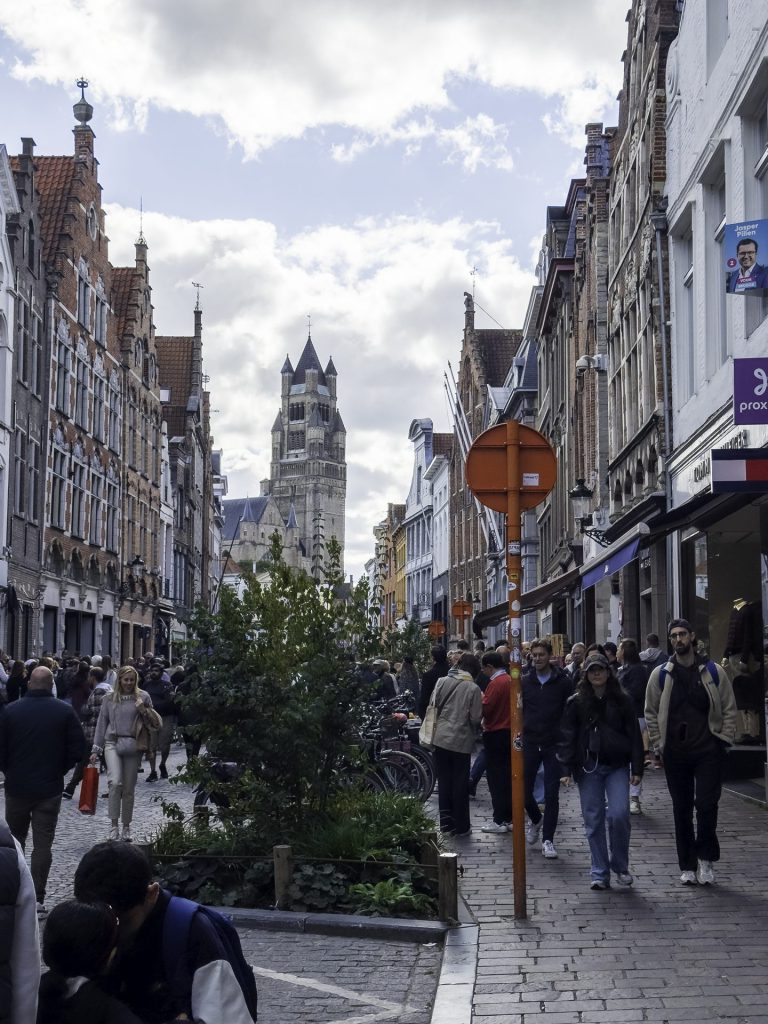
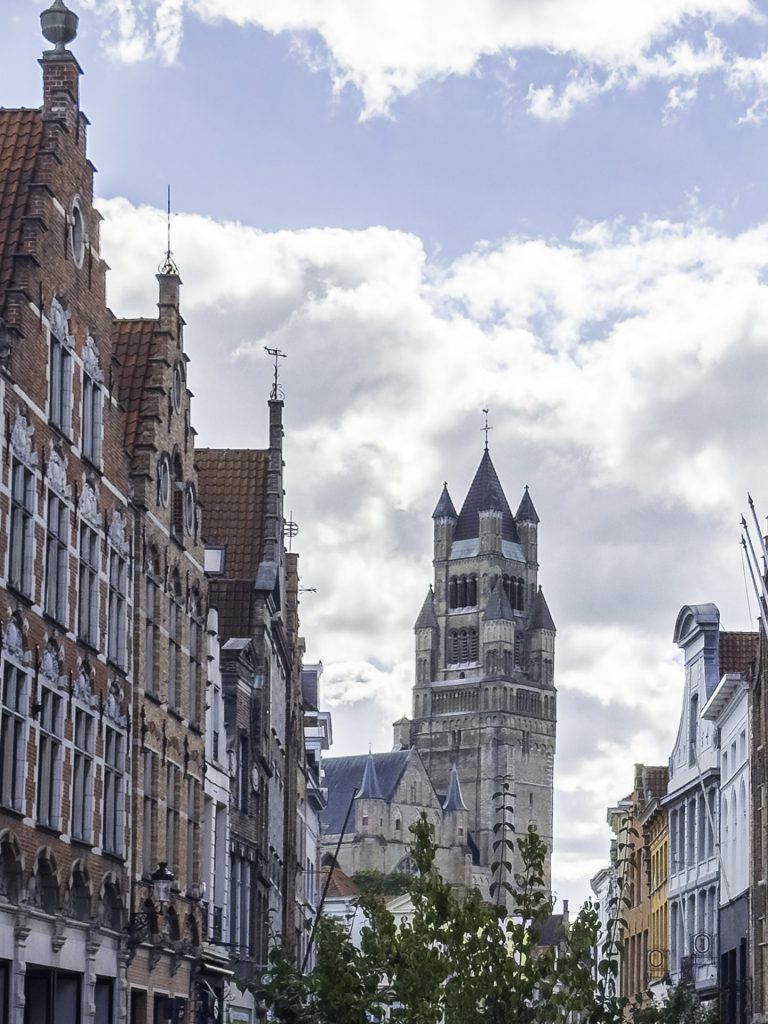
An image like many inconsiderate tourists make every day. In Bruges, I captured a street with an interesting church in the background. However, the photo was disturbed by busy shop signs and traffic poles. Zooming in and adjusting the angle made the composition calmer and more timeless (iPhone photo).
Take multiple shots
Photograph the same scene from different angles and settings. This increases your chances of avoiding interference. In post-processing, combine the best parts of multiple shots to create an interference-free final result.
Optimise your positioning and framing.
Choosing the correct position and using framing are crucial steps in creating timeless travel photos. With a few deliberate choices, you can avoid distracting elements and capture the essence of a place.
- Strategic positioning: Move yourself to keep distracting elements out of the frame. For example, photograph from a higher or lower vantage point to avoid distractions such as cables, road signs and modern disturbances.
- Use natural frames: Isolate your subject with arches, windows or trees. Natural frames add depth and focus and help avoid distractions.
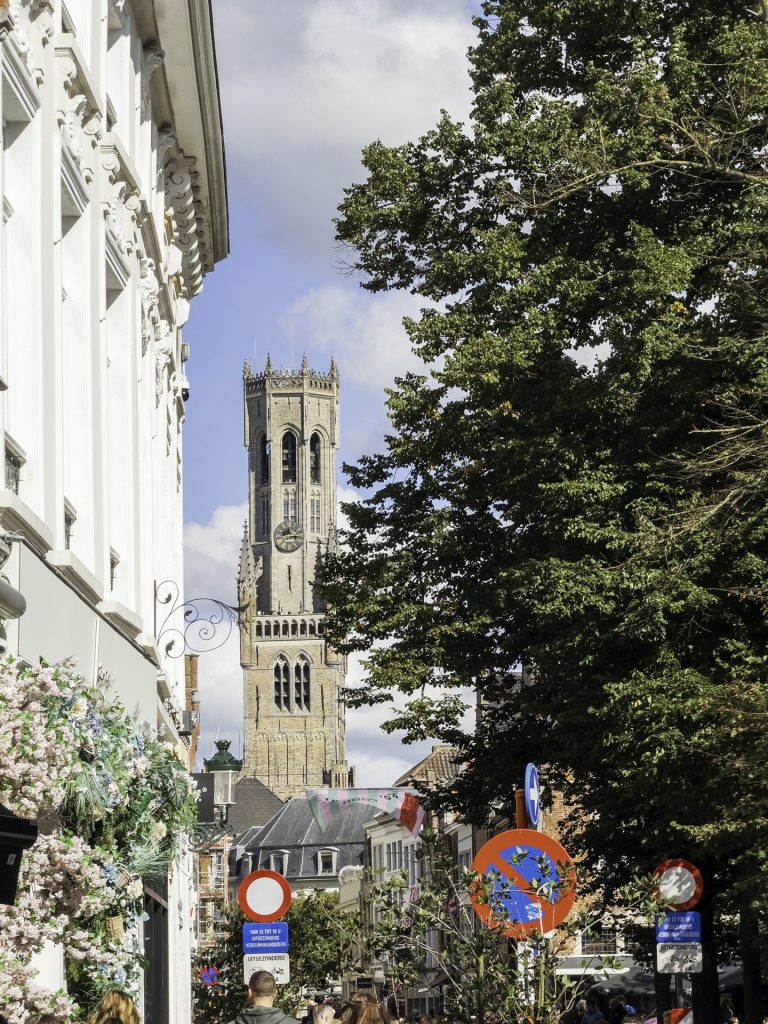
This picture shows a beautiful city view in Bruges. But this view is negated by the very present and very numerous traffic signs. Looking at the details, you will also find shop signs, flags, and an air-conditioning system. Taking a few steps forward and zooming in a bit was not a solution because then this ugly scaffolding on the left came into view, and you could also see electrical cables running across the street.
Tips for a timeless composition
- Combine framing and positioning: Zoom in to reduce distractions and use natural frames to create a visually appealing image.
- Try different compositions and angles to have multiple options. That way, after processing, you can choose the most timeless shot.
With a good balance of positioning and framing, you can transform even the most complex scenes into soothing, timeless compositions.
Control exposure
4. Post-processing tips for timeless travel photography
Lightroom and Photoshop:
1. Basic adjustments in Lightroom
Start with automatic corrections to optimise the basics of your photo. Then adjust specific settings, such as:
- Exposure: Balance between highlights and shadows. Use mask tools in Lightroom to dampen highlights or brighten shadows. Linear gradients can be used to dim too-bright walls.
- Colour: Add brightness (vibrance) for vividness, but avoid oversaturation—dim overexposed walls with linear gradients. Bring out details with brush masks, such as textures on a wall or vegetation. Play with shadows and highlights to add depth and atmosphere.
- Enhance details: Use the brush mask to make charming elements, such as a wall or vegetation, more visible. Combine photos in Photoshop to merge parts without tourists into one timeless image.
2. Remove distracting elements
Use Photoshop to remove modern disturbances and make your photo calmer:
- Spot healing brush & clone stamp: ideal for small objects such as cables, stickers or antennas.
- Content-aware fill is helpful for more prominent disturbances such as road signs, air conditioning units, or graffiti. Select the object and let Photoshop automatically fill the surrounding area.
- Generative fill: Use AI to replace complex disturbances (such as chairs or canopies) with natural details. This saves time and provides credible results. Using AI-driven generative fill, remove large interfering objects (e.g., chairs or canopies). Create a loose selection around the object and let Photoshop AI fill in what might be behind it. Check the result and finish with tools like the clone stamp for accurate detail.
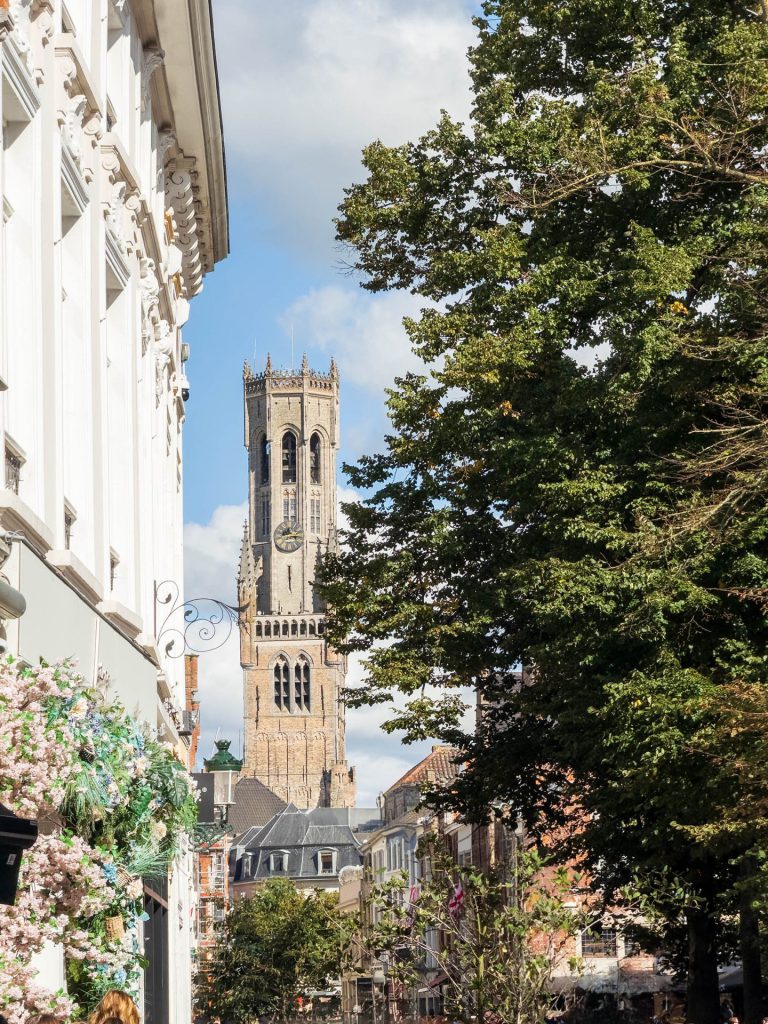
In this photo of the same view in Bruges, all distractions were eliminated in post-processing in Photoshop. You immediately get a much calmer and timeless image.


This façade of a house in Seville (Spain) looked perfect for a timeless photograph but was littered with cables and security cameras. Content-aware fill easily removes these disturbances, leaving an undisturbed image.
3. Adjust light and colour: Use advanced mask tools in Lightroom or Photoshop to make specific adjustments:
4. Sky replacement: You can replace a dull sky for dramatic photo enhancement.
- Photoshop: Replace the sky with a few clicks and adjust for reflections and light.
- Luminar NEO: This program creates realistic reflections in water and windows, ideal for a professional look. It is very user-friendly, and you can use it with just a few clicks.
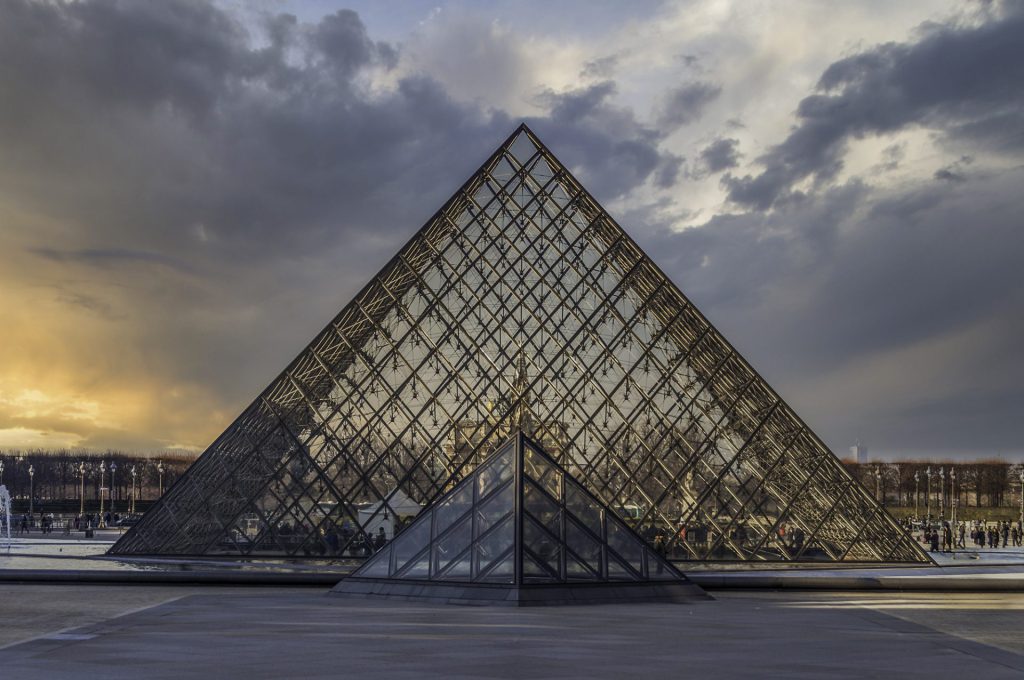
In this picture at the Louvre in Paris, I replaced a dull sky with a more dramatic sky in Luminar Neo. You can see that the sky was recognised even through the glass windows. Of course, I ensured the sun was in the right place.
5. Combine images for perfection: Combine multiple photos of the same scene in Photoshop. For example, merge tourist-free sections into one interference-free shot. This is especially useful in crowded locations.
6. For timelessness, use black-and-white post-processing to focus on shapes and contrasts. This technique works exceptionally well for architecture and landscapes.
If you are curious about how you can further increase the impact of your photo in post-processing, go and check out my blog
Timeless photos usually do well in black and white, too. I explain this in my blog tips for black-and-white landscape photos.
The process takes time but pays off: Although post-processing is an investment in time, it produces images that exude calm and capture the essence of a place. The result is a photograph that evokes emotions and tells stories.
5. Timeless travel photos under challenging conditions
- Experiment with angles and perspectives: Adjust your point of view to avoid interference:
- Photograph from a higher or lower point to keep elements such as cars, signs or cables out of view.
- Use natural barriers like trees or walls to hide disturbances.
2. Use post-processing to remove disturbances: If modern elements are unavoidable, you can remove them with tools like content-aware or generative fill. Combine multiple photos to remove tourists or vehicles.
3. Visit the location again: A location may look completely different at a different time or under various conditions:
- Visit a spot in the early morning for quieter images without tourists.
- Return in better light or in another season to avoid distracting elements.
4. Embrace creativity and limitations: Not every location suits a timeless photograph. Sometimes, modern elements cannot be avoided, but you can be creative with framing and lighting to make them less distracting. Remember that not every photo needs to be perfect; it’s all about capturing the moment.
Tip: Plan your visits and research busy locations to have fewer distractions. Social media and apps such as Google Earth can help find quiet moments.
These techniques allow you to create timeless images that capture the essence of a place, even in challenging conditions.
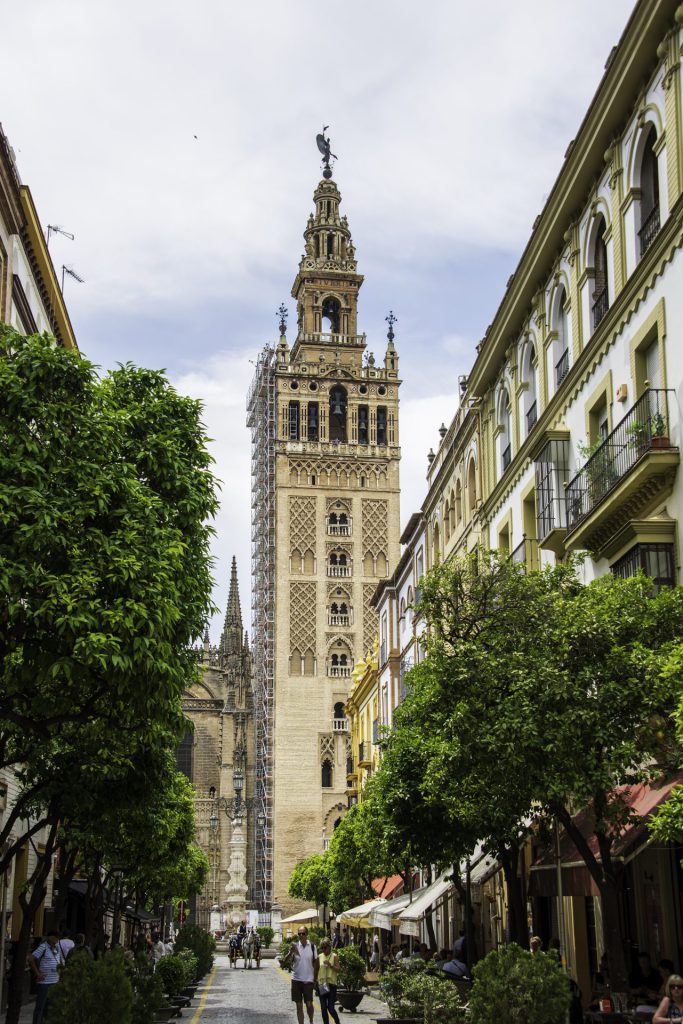
In this photo in Seville, you don’t only notice antennas and alarms that you could quickly get rid of in post-processing if necessary. You could also get rid of the tourists with reframing. But the entire tower is in the scaffolding. Which obviously can’t produce a timeless image. You might not notice it on social media on a small screen. So, to make an undisturbed picture, I would have to return it a few months or a year later.
6. Take your time
Slow down and observe
One of the most essential lessons in travel photography is taking time. Photography is about technical perfection and capturing a place’s atmosphere, emotions, and unique details. Slowing down your pace will improve your photos and allow you to enjoy your travel experience.
Many travellers search for the next landmark in a city or landscape. But instead of running, it is better to pause for a moment. Look around you carefully and let the surroundings affect you. Take your time to observe the details, colours, and interactions that make a place unique. A slow pace lets you plan your photos and wait for the right moment. Think of the perfect light or a spontaneous scene unfolding before your eyes.
In a world where everything has to happen fast, taking time is both a luxury and a strength. By photographing attentively and patiently, you can create images that are not only beautiful but tell a story. That is what distinguishes timeless travel photography from fleeting snapshots. So, next time you travel, remember to slow down, enjoy, and let the moment’s magic flow into your lens.
Enjoy the moment
Travel photography should not feel like a task to be ticked off. Before you pick up your camera, it is worth taking a moment to enjoy where you are. Order a coffee on a terrace, sit in a square and observe the everyday life around you. When relaxed, you often see more interesting moments you would otherwise miss. Moreover, this relaxed attitude usually shines through in your photos: the compositions become more natural and spontaneous.
Explore side streets and alternative routes.
The magic of a destination often lies off the beaten track. While tourist hotspots usually yield beautiful images, the side streets, small alleys, and unexpected winding roads can capture the fundamental soul of a place. You might come across a picturesque wall, a charming shop, or a local willing to pose for you. By taking unfamiliar roads, you will discover places and stories that will make your travel photos unique and timeless.
Be surprised
Not focusing on the ‘perfect photo’ gives you room to be surprised. Photography is often about being in the right moment and place. Sometimes, these are not the familiar views but the small, unforeseen moments: children playing in the street, a busker with a catchy song, or just a ray of light hitting a wall.
Revisiting locations for better shots
Return to the exact location under different conditions (weather, light, time of day). The goal is to make one exceptional photo, not several good ones. Go back with the improvement mindset and aim for a striking, “over-the-top” shot.
7. Need ideas for your next trip?
1. Use social media for inspiration: Platforms like Instagram and Pinterest are excellent sources to find photogenic locations. Search on hashtags such as #travelphotography or specific destinations to view images that appeal to you. Make a list of places you want to visit.
Tip: Check photography-focused accounts or use tools like Google Earth to discover unique perspectives and routes.
2. Immerse yourself in local events and traditions: Authentic moments can often be found during festivals, markets or local celebrations. Research in advance if there are any events during your visit. They will give your photos a unique character and offer an insight into the local culture.
3. Look off the beaten track: Popular destinations are photogenic and crowded. Explore lesser-known routes or places to capture an authentic atmosphere. Think small villages, remote nature reserves or hidden alleys in cities.
4. Use travel guides and blogs: Online travel guides offer elaborate itineraries and ideas for hiking, cycling or road trips. They help you find the most beautiful places and plan your trip efficiently.
5. List must-have shots: Decide what images you want to capture. Think landscapes, architecture, street scenes or portraits. A list helps you focus but leaves room for spontaneous moments.
Tip: Read photography blogs to learn famous sights’ best times and angles. In my travel photography blog, I go into even more detail on preparing for a photo trip.
5. Plan your trip with photography in mind: Compile a list of photography locations and consider the best time to visit them. Consider the light, crowds and possible weather conditions. Preparation will prevent you from missing beautiful moments.
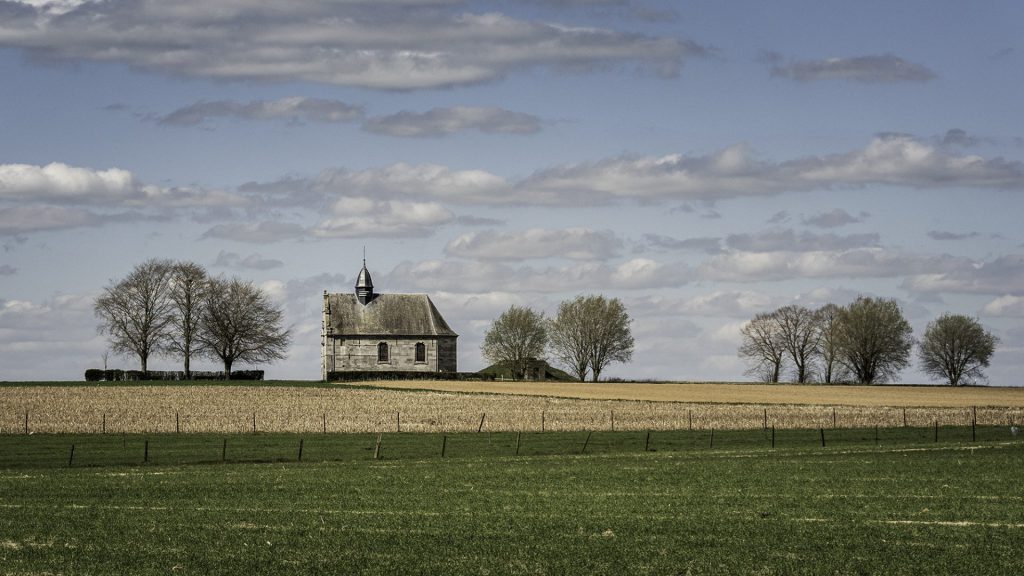
When people think of timeless travel photographs, they often think only of urban scenes. But landscapes are also timeless, almost by definition. In this photo, I had to remove a screaming traffic sign post-processing.
8. Conclusion: Let timelessness speak through your lens
Timeless travel photography goes beyond making beautiful images. It is the art of capturing the soul and atmosphere of a place. You can create images that evoke emotions and tell stories by avoiding distracting elements, playing with light and composition, and patiently observing.
Remember: timeless photographs are not perfect through technical precision alone. They touch the viewer by expressing a sense of wonder, nostalgia or sheer beauty. Be guided by your intuition and experiment with the techniques you have learned.
Now is the time to hit the road. Grab your camera, slow your pace and look at the world around you. Be inspired by your surroundings and capture moments that will stand the test of time.
Your masterpiece awaits you. Where does your next adventure begin?
Please enter your questions or comments below, and maybe share a photo with us.
Leave a reply